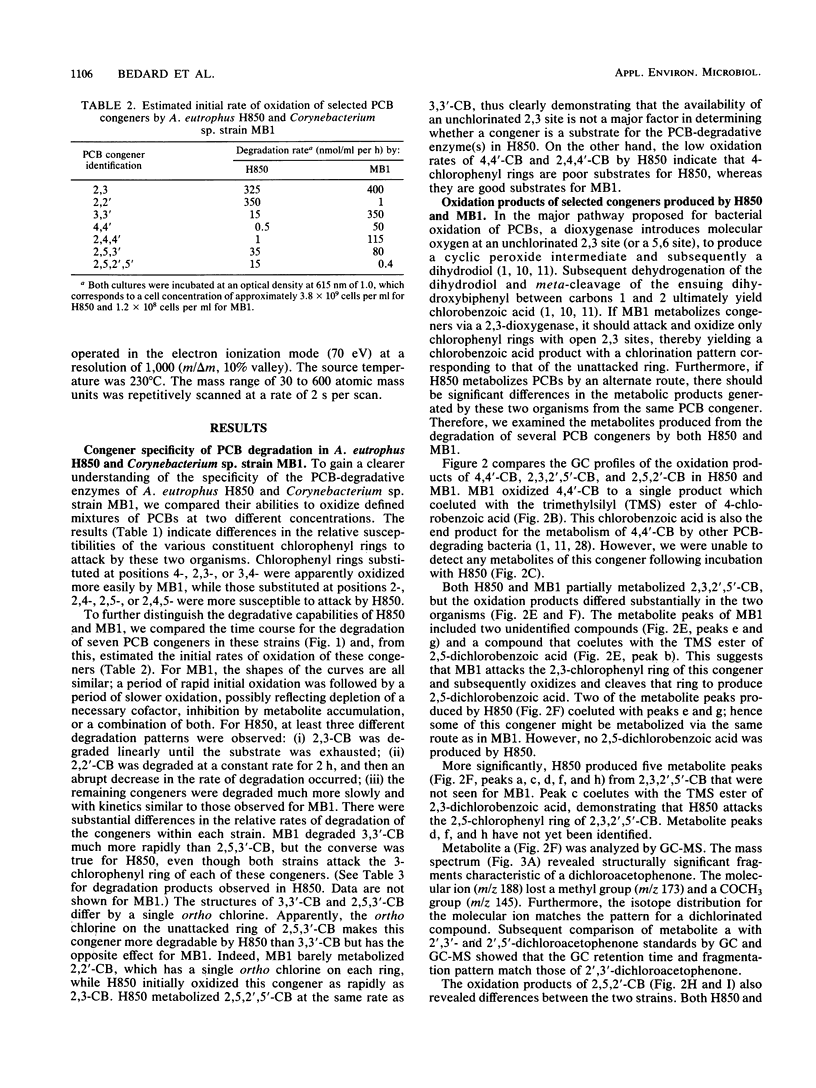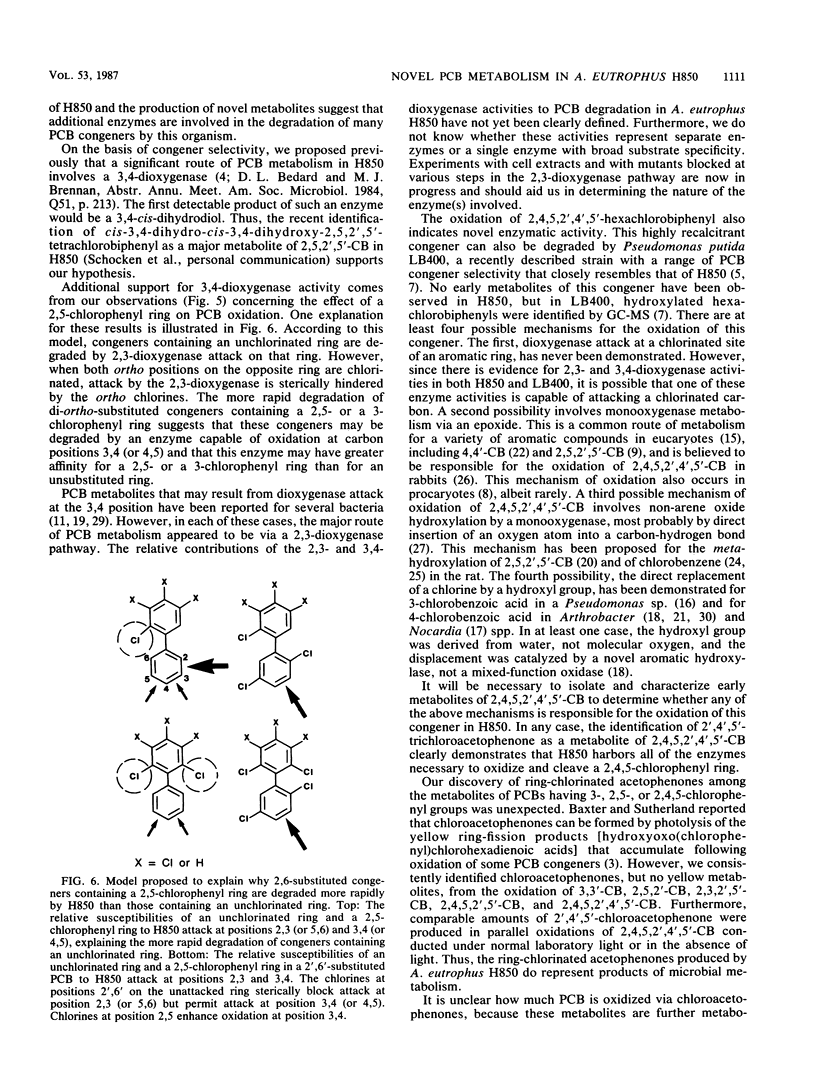Abstract
Previous studies indicated that Alcaligenes eutrophus H850 attacks a different spectrum of polychlorinated biphenyl (PCB) congeners than do most PCB-degrading bacteria and that novel mechanisms of PCB degradation might be involved. To delineate this, we have investigated the differences in congener selectivity and metabolite production between H850 and Corynebacterium sp. strain MB1, an organism that apparently degrades PCBs via a 2,3-dioxygenase. H850 exhibited a superior ability to degrade congeners via attack on 2-, 2,4-, 2,5-, or 2,4,5-chlorophenyl rings in PCBs but an inferior ability to degrade congeners via attack on a 4-chlorophenyl ring. Reactivity preferences were also reflected in the products formed from unsymmetrical PCBs; thus MB1 attacked the 2,3-chlorophenyl ring of 2,3,2',5'-tetrachlorobiphenyl to yield 2,5-dichlorobenzoic acid, while H850 attacked the 2,5-chlorophenyl ring to yield 2,3-dichlorobenzoic acid and a novel metabolite, 2',3'-dichloroacetophenone. Furthermore, H850 oxidized 2,4,5,2',4',5'-hexachlorobiphenyl, a congener with no adjacent unsubstituted carbons, to 2',4',5'-trichloroacetophenone. The atypical congener selectivity pattern and novel metabolites produced suggest that A. eutrophus H850 may degrade certain PCB congeners by a new route beginning with attack by some enzyme other than the usual 2,3-dioxygenase.
Full text
PDF









Selected References
These references are in PubMed. This may not be the complete list of references from this article.
- Ahmed M., Focht D. D. Degradation of polychlorinated biphenyls by two species of Achromobacter. Can J Microbiol. 1973 Jan;19(1):47–52. doi: 10.1139/m73-007. [DOI] [PubMed] [Google Scholar]
- Baxter R. A., Gilbert P. E., Lidgett R. A., Mainprize J. H., Vodden H. A. The degradation of polychlorinated biphenyls by micro-organisms. Sci Total Environ. 1975 May;4(1):53–61. doi: 10.1016/0048-9697(75)90014-5. [DOI] [PubMed] [Google Scholar]
- Bedard D. L., Unterman R., Bopp L. H., Brennan M. J., Haberl M. L., Johnson C. Rapid assay for screening and characterizing microorganisms for the ability to degrade polychlorinated biphenyls. Appl Environ Microbiol. 1986 Apr;51(4):761–768. doi: 10.1128/aem.51.4.761-768.1986. [DOI] [PMC free article] [PubMed] [Google Scholar]
- Bedard D. L., Wagner R. E., Brennan M. J., Haberl M. L., Brown J. F., Jr Extensive degradation of Aroclors and environmentally transformed polychlorinated biphenyls by Alcaligenes eutrophus H850. Appl Environ Microbiol. 1987 May;53(5):1094–1102. doi: 10.1128/aem.53.5.1094-1102.1987. [DOI] [PMC free article] [PubMed] [Google Scholar]
- Bowman W. R., Gretton W. R., Kirby G. W. Hydroxylation of phenylalanine by Pseudomonas sp.: measurement of an isotope effect following the NIH shift. J Chem Soc Perkin 1. 1973;3:218–220. doi: 10.1039/p19730000218. [DOI] [PubMed] [Google Scholar]
- Forgue S. T., Allen J. R. Identification of an arene oxide metabolite of 2,2',5-5'-tetrachlorobiphenyl by gas chromatography-mass spectroscopy. Chem Biol Interact. 1982 Jun;40(2):233–245. doi: 10.1016/0009-2797(82)90103-x. [DOI] [PubMed] [Google Scholar]
- Furukawa K., Tomizuka N., Kamibayashi A. Effect of chlorine substitution on the bacterial metabolism of various polychlorinated biphenyls. Appl Environ Microbiol. 1979 Aug;38(2):301–310. doi: 10.1128/aem.38.2.301-310.1979. [DOI] [PMC free article] [PubMed] [Google Scholar]
- Furukawa K., Tonomura K., Kamibayashi A. Effect of chlorine substitution on the biodegradability of polychlorinated biphenyls. Appl Environ Microbiol. 1978 Feb;35(2):223–227. doi: 10.1128/aem.35.2.223-227.1978. [DOI] [PMC free article] [PubMed] [Google Scholar]
- Hopper D. J., Elmorsi E. A. Cleavage of formate from omega,4-dihydroxyacetophenone. An unusual oxygen-requiring reaction in the bacterial catabolism of 4-hydroxyacetophenone. Biochem J. 1984 Feb 15;218(1):269–272. doi: 10.1042/bj2180269. [DOI] [PMC free article] [PubMed] [Google Scholar]
- Jerina D. M., Kaubisch N., Daly J. W. Arene oxides as intermediates in the metabolism of aromatic substrates: alkyl and oxygen migrations during isomerization of alkylated arene oxides. Proc Natl Acad Sci U S A. 1971 Oct;68(10):2545–2548. doi: 10.1073/pnas.68.10.2545. [DOI] [PMC free article] [PubMed] [Google Scholar]
- Marks T. S., Wait R., Smith A. R., Quirk A. V. The origin of the oxygen incorporated during the dehalogenation/hydroxylation of 4-chlorobenzoate by an Arthrobacter sp. Biochem Biophys Res Commun. 1984 Oct 30;124(2):669–674. doi: 10.1016/0006-291x(84)91607-3. [DOI] [PubMed] [Google Scholar]
- Massé R., Messier F., Péloquin L., Ayotte C., Sylvestre M. Microbial biodegradation of 4-chlorobiphenyl, a model compound of chlorinated biphenyls. Appl Environ Microbiol. 1984 May;47(5):947–951. doi: 10.1128/aem.47.5.947-951.1984. [DOI] [PMC free article] [PubMed] [Google Scholar]
- Mires M. H., Alexander C. H. The prophylactic treatment tuberculosis. Del Med J. 1972 Jul;44(7):187–190. [PubMed] [Google Scholar]
- Preston B. D., Miller J. A., Miller E. C. Non-arene oxide aromatic ring hydroxylation of 2,2',5,5'-tetrachlorobiphenyl as the major metabolic pathway catalyzed by phenobarbital-induced rat liver microsomes. J Biol Chem. 1983 Jul 10;258(13):8304–8311. [PubMed] [Google Scholar]
- Ruisinger S., Klages U., Lingens F. Abbau der 4-chlorbenzoesäure durch eine Arthrobacter-Species. Arch Microbiol. 1976 Nov 2;110(23):253–256. doi: 10.1007/BF00690235. [DOI] [PubMed] [Google Scholar]
- Safe S., Jones D., Hutzinger O. Metabolism of 4,4'-dihalogenobiphenyls. J Chem Soc Perkin 1. 1976;(4):357–359. [PubMed] [Google Scholar]
- Selander H. G., Jerina D. M., Daly J. W. Metobolism of chlorobenzene with hepatic microsomes and solubilized cytochrome P-450 systems. Arch Biochem Biophys. 1975 May;168(1):309–321. doi: 10.1016/0003-9861(75)90255-6. [DOI] [PubMed] [Google Scholar]
- Selander H. G., Jerina D. M., Piccolo D. E., Berchtold G. A. Letter: SyntheSis of 3- and 4-chlorobenzene oxides. Unexpected trapping results during metabolism of ]14-c[chlorobenzene by hepatic microsomes. J Am Chem Soc. 1975 Jul 23;97(15):4428–4430. doi: 10.1021/ja00848a066. [DOI] [PubMed] [Google Scholar]
- Tomaszewski J. E., Jerina D. M., Daly J. W. Deuterium isotope effects during formation of phenols by hepatic monoxygenases. Evidence for an alternative to arene oxide pathway. Biochemistry. 1975 May 6;14(9):2024–2031. doi: 10.1021/bi00680a033. [DOI] [PubMed] [Google Scholar]


